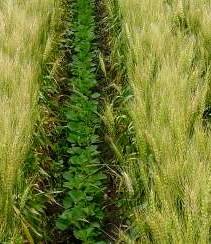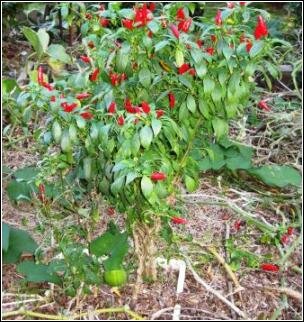Intercropping, Polyculture or Relay Cropping in the vegetable Garden
Intercropping is in! Whether you call it relay cropping, polyculture, double crop or multiple cropping... it’s a specific form of companion planting and a fine way to increase the harvest from your garden.
Bare soil is a no no.
Nature... if left to be natural... rarely allows nudity and likes to cover up exposed bits.
This stops the soil drying out or being washed away and keeps the soil organisms happy and protected from the elements.
So growing several or multiple crops of different plants in the same area, each allowing for their own growth patterns and needs, gives you greater returns and less work.
Intercropping/Polyculture Benefits

No doubt you’ve heard of monoculture? Possibly you do have an idea... but I still have to say you have no idea what a short-sighted folly it is to follow the vast monoculture practices that we do in the world today.
Monoculture — Mono means one. One crop, say corn, covering as far as the eye can see in every direction! Or, one country with every farmer growing the same crop, say potatoes, on large and small plots.
Now can you see the specific corn pest or virus go giddy with excitement? Can you hear the potato pest or potato blight text their mates to come to the party?
The same thing can happen in a mini way to your garden if you grow all one sort of plant, or large blocks of one variety. The opposite of monoculture is polyculture — Poly means many. See how confused the pests and diseases are now. There are no feasts to encourage them to get a firm foothold and cause problems.
Often you can plant a crop of two or more different varieties of the same family, but checking that they each have different disease resistance.
Intercropping Examples
Let’s take a large plant such as a cabbage. Although it starts small it grows a lot chunkier. Same with other brassicas such as broccoli and Brussels sprouts; and same as vines like zucchini or squash.
In the meantime and in between — plant speedy crops like radish, rocket or leafy lettuce. By the time the main plants grow into their surrounding space, you will have harvested and enjoyed a meal or more of your intercrop plants.
Even with rows you can intercrop, or doublecrop as it’s often called. A common example is to sow slow parsnips with fast radishes together in rows. Parsnip seeds take forever and a day to germinate, but cheeky radishes will pop up, mark the rows for you, and you can crunch your way through them which will then leave space for the parsnips to grow.
End of season picture of chilli plant underplanted with vines

Intercropping can be described as undercropping when it comes to ‘vertically challenged’ plants. Little shorties of the leafy varieties like lettuce which like some sun protection, can be grown in the shade of the tallest plants such as broad beans or corn.
The short crop also acts as a living mulch for the roots of the tall plants.
The classic “Three Sisters” combination planted by Native Americans is a perfect example of intercropping or plant combining.
The Three Sisters describes three indigenous plants grown together. Corn (maize) with their tall stalks provided support for beans and shade for squash. In turn the squash vines provided a living mulch to control weeds and protect the roots of the corn and beans. The prickly squash vines deter pests as well.
Makeup cropping (I made up that word) means filling up a bare patch, which we know nature abhors, with a makeup crop... usually a gaggle of fast salad plants like radish, lettuce, bok choy etc... that you can make up a salad with!
This takes care of that garden patch where you’ve eaten the last skerricks of say a winter crop of cauli and you want to plant some spuds there but it’s too early; so use the patch for some quick, small plants that you’ll be finished within a month or so.
Intercropping Tips
Stuffing your garden to the gunnels is not exactly the idea with polyculture. Cramming too much into every spare space can create problems with fungal diseases due to reduced air flow.
Also an over-heavy layer of plants increases the need to water more often. It also makes harvesting difficult.
Any time you see that your main crop is being hampered by a second or third crop, take a step back and sort them all out... in fact pull a few plants out and restore some order to the melee. Peace must reign in your garden for success. No fighting allowed!
The Golden rule with intercropping is to use the available planting area to its maximum advantage to get maximum yields without compromising plant health.





